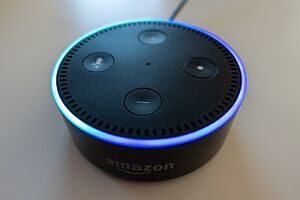Virtual assistant facts for kids
A virtual assistant (VA) is a computer program that helps people perform tasks. It acts like a digital helper. Users can talk to it or type commands to ask questions or control devices. These assistants use artificial intelligence (AI) to understand human language and give helpful answers.
Common examples include Siri on Apple devices, Amazon Alexa, and Google Assistant. In the 2020s, new AI tools like ChatGPT and Microsoft Copilot made these assistants much smarter, allowing them to have long conversations and write text.
Contents
History of Virtual Assistants
Early Voice Machines
Long before smartphones existed, inventors wanted to create machines that could understand the human voice.
- Radio Rex (1911): This was the first voice-activated toy. It was a wooden dog that would come out of its house when someone called its name.
- Audrey (1952): Scientists at Bell Labs built a huge machine called Audrey. It was six feet tall and could understand spoken numbers from 0 to 9.
- IBM Shoebox (1961): This device could do math. It understood 16 spoken words and digits.
- ELIZA (1960s): This was an early computer program that chatted with people using text. It pretended to be a therapist. It showed that computers could simulate a conversation, even if they didn't truly understand the meaning.
The Rise of Smart Assistants
As computers became faster, voice technology improved.
- Dragon NaturallySpeaking (1997): This software allowed people to type documents just by speaking. It could type about 100 words per minute.
- Siri (2011): Apple introduced Siri on the iPhone 4S. It was the first modern assistant on a phone that could answer questions, check the weather, and set alarms.
- Alexa (2014): Amazon released the Echo smart speaker. This brought virtual assistants into the living room, allowing users to play music and control their homes with their voice.
- Generative AI (2020s): In late 2022, ChatGPT was launched. It used advanced AI to answer complex questions and write stories. This led to a new generation of assistants like Google Gemini and Microsoft Copilot.
How Do Virtual Assistants Work?

Virtual assistants use a technology called Natural Language Processing (NLP). This allows the computer to turn spoken sounds or typed text into commands it can understand.
Ways to Interact
There are three main ways to communicate with a virtual assistant:
- Voice: You speak to the device. This is common with smart speakers and phones.
- Text: You type questions in a chat window. This is used by customer service bots and AI like ChatGPT.
- Images: Some assistants, like Google Lens, can "see." You can show them a picture of a flower, and they will tell you what kind it is.
Wake Words
To save power and protect privacy, voice assistants usually do not record everything. They wait for a special "wake word" to start listening. Common wake words include:
- "Hey Siri"
- "Alexa"
- "OK Google"
Where Can You Find Them?
Virtual assistants are found in many different devices:
- Smart Speakers: Devices like the Amazon Echo, Google Home, and Apple HomePod sit in your house and wait for commands.
- Smartphones: Almost every modern phone has an assistant built-in.
- Computers: Microsoft Windows computers use Copilot, and Macs use Siri.
- Smart Home Devices: Some TVs, light bulbs, and thermostats can be controlled by voice.
- Cars: Many cars allow drivers to ask for directions or change the music without taking their hands off the wheel.
What Can They Do For You?
Virtual assistants can help with many daily tasks:
- Information: They can answer questions like "What is the capital of Japan?" or "Who won the football game?"
- Entertainment: They can play music from services like Spotify, read audiobooks, or play videos on a TV.
- Organization: They can set timers for cooking, create shopping lists, and remind you to do homework.
- Smart Home Control: You can ask them to turn off the lights or lock the front door.
- Translation: They can translate phrases into different languages instantly.
Privacy and Safety
Because virtual assistants have microphones, it is important to understand how they handle privacy.
How They Listen
Most devices listen only for the wake word. Once they hear it, they start recording your voice to understand your command. These recordings are often sent to the internet (the cloud) to be processed.
Protecting Your Data
Companies like Apple, Amazon, and Google have rules about privacy.
- Google Assistant: Does not store audio without permission. You can change settings to stop it from saving your history.
- Amazon Alexa: Records after the wake word. You can delete your voice recordings in the app.
- Apple Siri: Tries to process data on the phone instead of sending it to the cloud when possible.
It is always good to check the privacy settings on your devices to stay safe.
Comparison of Popular Assistants
Here is a list of some of the most common virtual assistants available today.
| Name | Company | Common Devices |
|---|---|---|
| Alexa | Amazon | Echo speakers, Fire TV |
| Google Assistant | Android phones, Google Nest speakers | |
| Siri | Apple | iPhone, iPad, Mac, HomePod |
| Copilot | Microsoft | Windows computers |
| Bixby | Samsung | Samsung Galaxy phones, Samsung appliances |
See also
 In Spanish: Asistente virtual para niños
In Spanish: Asistente virtual para niños
- Applications of artificial intelligence
- Artificial conversational entity
- Artificial human companion
- Autonomous agent
- Computer facial animation
- Expert system
- Friendly artificial intelligence
- Home network
- Hybrid intelligent system
- Intelligent agent
- Interactions Corporation
- Knowledge Navigator
- Office Assistant
- Multi-agent system
- Simulation hypothesis
- Social bot
- Social data revolution
- Software bot
- Wizard (software)


